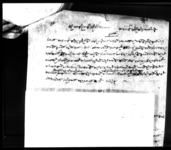A letter from the Guṭhī Bandobasta to the Jaṅgī Koṭavālī of Bhaktapur re the confiscation of the property of the priest Jogabāhādura (VS 1977)
ID: K_0262_0059
Edited and
translated by Ramhari Timalsina
Created: ;
Last modified: 2021-01-29
For the metadata of the document, click here
The accompanying edition, translation/synopsis and/or commentary are available under the terms of the Creative Commons Attribution-ShareAlike 4.0 International License
Abstract
A statue of Tripurasundarī having been stolen in Bhaktapur, this letter from the Guṭhī Bandobasta Aḍḍā orders the Jaṅgī Koṭavālī of Bhaktapur to confiscate property belonging to the priest Jogabāhādura Karmācārjye, accused of negligence leading to the theft.Diplomatic edition
[1r]
1[...]1⟪2110⟫1⟪२५[...]⟫1श्री५सर्कारतर्फगुठीवंदोवस्तवाट भादगाऊजंगीकोटवालीके2
2भयाकोहुनाले१छापेपुर्जीवमोजींजीम्मालीनेपुजाहारीभादगाऊतुलाछेवस्नेजोगवाहादुर
3कर्माचार्ज्येलेभर्नाराख्नमंजुरनगरेकोभैजायेजातवाटऊपरगर्नुपरेकोहुनालेनीजकोघरधं
4मालश्रीसंपतीजगाज्मींजायेजातगरीसोचोरीभयाकोवीगोमोरु२५८।८७ऊपरगर्नुपर्दा
5जायेजाततायेदातगर्नलाईयेसअडाकोकारीन्दाहरीनारांस्मेतलाईषटाईपठाईदीयाकोछतेस
6अडास्मेत⟪जोचाहीनेमदतदीसाछीस्मेत⟫साछीवसीअैंसवालकोरीतपुर्याई⟪लुकाऊनदवाऊननपाऊनेगरीभयेकोवाट⟫जायेजाततायेजातगरीलीलांवीक्रीगर्नेस्मेतकां
7भयेवेसहोलाईतीसम्वत१९७७सालफागुं गतेरोज ¯¯ ¯¯¯¯
Translation
[1r]
10
No. 251
A purjī from the Guṭhī Bandobasta [Aḍḍā] of Śrī 5 Sarkāra to the BhādagāūJaṅgī Koṭavālī
Uprānta: Since the golden statue 2 of glorious (Śrī) Tripurasundarī that was made and installed by the Sarkāra3 was stolen, and since the priest Jogabāhādura Karmācārjye, a resident of Tulāche [in] Bhādagāū, who was responsible for taking care of it, refused to make restitution following [an order in] a 1-chāpe4 purjī, [the amount] needs to be collected from his [share of] property. [Therefore,] in order to collect the value (bigo) of the stolen [statue amounting to] 258 morus and 87 paisās by confiscating his house, personal belongings, wealth and lands, Harīnārāṃ, an official of this office (i.e., the Guṭhī Bandobasta Aḍḍā), has been despatched there. It would be good if your (lit. that) office provided necessary help: standing witness so that Ain and Savāla5 rules are adhered to, carrying out the confiscation from among what [the priest] owns so that he is unable to hide or conceal [anything] and conducting the auction.
On …6 , the ...7 of Phāguṃ in the [Vikrama] era year [19]77 (1921 CE). Auspiciousness.
Commentary
See the commentary of K_0262_0056.

